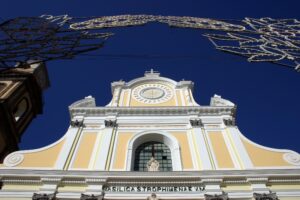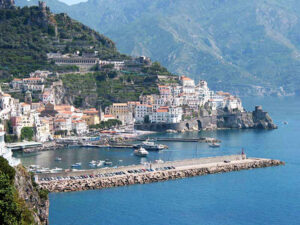MUNICIPALITY: Ravello
NAME: Church of St. Pietro alla Costa.
LOCATION: Via Loggetta.
DESCRIPTION::Dating back to the 10th century and preceded by a portico with seven columns supporting vaults of different types, the church shows the structure rebuilt after it collapsed in the mid-18th century (the columns and part of the portico must have belonged to the church itself); it has a single nave flanked by a smaller nave, divided by masonry pillars and with an entrance next to the main one. The larger nave has a square apse containing the altar and a painting of the Virgin.
The bell tower ends with a small dome that rests on a cube, which likewise rests on the lower register, forming a fold.
SEE, VISIT, FIND: The church is open during liturgical celebrations, that is, by contacting the pastor of the Sanctuary of the SS. Cosma e Damiano.
FRUITION DATA: None.
OPPORTUNITIES: One could present the structures with external panels, so that the church is always usable for visitors. Similar evidence, often little known, would be better enhanced by a tour itinerary (possibly guided) dedicated to the religious architecture of Ravello.
BIBLIOGRAFIA: FULCHIGNONI G., Ravello. Le cento chiese, Amalfi 2001
IMPERATO G., Ravello nella storia civile e religiosa, Cava d. T. 1990.
MANSI L., Ravello sacra-monumentale, Ravello 1887
CHIESA DI SAN PIETRO ALLA COSTA
” La Chiesa con il portico (1)”The Church of San Pietro alla Costa, dating from the 10th century, is considered one of the oldest liturgical monuments in Ravello. The location in which the building stands, that is, on the slopes of Mount Civita, on the side leading to the cove of Marmorata, suggests that the foundation can be attributed to the initiative of a wealthy merchant family, residing near the ancient commercial dock of the duchy. The dedication, which has the founder of the Roman Catholic Church as its protagonist, would also confirm the commission by Ravello merchants, since they had also had churches dedicated to the saint built in Bari and Melfi.
The structure follows the typically local Romanesque style with an entrance preceded by a portico supported by granite columns with Roman spolia capitals. Some of the church’s marble columns have been moved since the 18th century, years in which the building was styled Baroque. The square-shaped apse houses the high altar, supported by ten marble columns. Behind the latter, a painting depicting Saints Peter and Paul with hosts of angels surrounding the Madonna can be seen. On either side are two canvases, a “Deposition” and a “Virgin and the Divine Infant,” of unknown workmanship. Over time, the church has been provided with new rooms and furnishings, such as a noteworthy marble baptismal font from 1629, donated by Domenico Russo.
The building, to be rediscovered for its historical and artistic value, stands in an extremely favorable place from a landscape point of view. From here, in fact, one can observe from a different perspective the coast below, rich in slopes and terraces cultivated with lemons.





